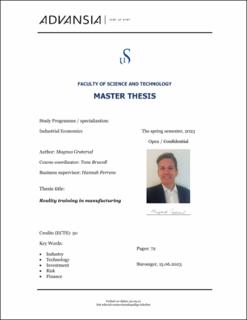| dc.description.abstract | This thesis aims to answer whether manufacturing companies should develop reality training
for production based on analysis and comprehensive literature study. The thesis will investigate
the analysis of reality training in technology, investment, risk, and financial aspects. Hence, it
will answer the following research question: What are the consequences of establishing reality
training in manufacturing?
To answer the technology and investment aspect of reality training, current research has
been done from the research of literature, companies, and relevant investment support. There
have been a Technology & Investment analysis of the current research’s most critical drivers
and barriers to creating a result. The result wants to find which one of the aspects is the most
critical factors in reality training.
In terms of the risk aspect, the thesis will conduct a comprehensive risk analysis by
comparing reality training with traditional training methods, focusing on critical operations.
By examining existing critical operations in traditional training, the study aims to determine
the impact level of risk when utilizing reality training in production settings. The risk analysis
will specifically utilize a case study involving critical operations at Beyonder, a Norwegian
battery manufacturing company. The findings from this analysis will shed light on whether
reality training has an influence on the level of risk in production compared to traditional
training methods.
In terms of the financial aspects, the thesis aims to conduct a comprehensive Financial
Statement analysis comparing the utilization of reality training with traditional training
methods, specifically focusing on Norske Skog Skogn. The analysis will be conducted through
two distinct cases, with the objective of determining the total EBITDA over a six year period.
Case 1 will investigate the change in EBITDA between traditional and reality training
for one year. This case will examine the implementation of virtual reality training to establish
a new factory, considering an average training duration of 3 months to 1 year before the factory
begins generating revenue. In Case 2, the analysis will focus on evaluating the cumulative
net present value, specifically examining the investment benefits and costs related to the
implementation of mixed reality over a period of five years. As part of this evaluation, the
thesis will consider the impact of investment benefits on OPEX, comparing the changes in
EBITDA between traditional and reality training.
By evaluating the outcomes of these two cases, the thesis will provide a Financial Statement
analysis result of the changes in EBITDA over a six year period, specifically focusing on the
transition from traditional training to reality training. This analysis will contribute to a better
understanding of the financial aspect of reality training within the context of Norske Skog
Skogn. | |
